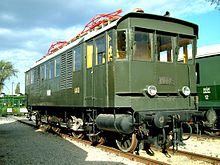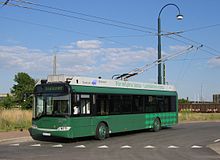Whole (company)
| Ganz Holding Co. Ltd.
|
|
|---|---|
| legal form | Ltd. |
| founding | 1844 (as Ganz & Cie ) |
| Seat | Budapest , Hungary |
| Branch | Railway manufacturers , armaments industry, mechanical engineering , electrical engineering , bridge construction , automobile manufacturers , engine manufacturers , shipbuilding |


Ganz ( Hungarian : Ganz vállalatok ; German: “Ganz Group”; today's name of the company: Ganz Holding Co. Ltd. ) is a mechanical engineering , electrical engineering and bridge building company founded by Ábrahám Ganz in later Budapest as Ganz & Cie . Ganz used to be active in the manufacture of automobiles , aircraft engines and shipbuilding . After the amalgamation of the Ganz locomotive and wagon factory with the neighboring company MÁVAG - another machine and wagon manufacturer - in 1959, this part of the company operated as Ganz-MÁVAG, until it was converted back into independent companies in 1988 and the name MÁVAG then disappeared. GANZ has been a holding company with various subsidiaries since 1990 .
history
The Ganz Group was founded in Buda in 1844 by the Swiss- born industrialist Ábrahám Ganz as an iron foundry , who had learned the carpentry and foundry trade at a young age and came to Pest as a trader in 1841 .
At the beginning, Ganz & Cie was primarily known as a railway manufacturer who manufactured railway wheels , axles and other relevant components. During the War of Independence in 1848 , his plants produced cast parts for rifles and cannons . After the end of the war, Ganz tried to develop the invention of the Englishman Burns for casting wagon wheels and patented his own solution in 1855; many of his successes were based on this patent .
The owner Ábrahám Ganz later founded holdings in companies in mechanical engineering ("Ganz-MÁVAG" with participation from MÁVAG and Csepel from Manfréd Weiss from Budapest ), electrical engineering and automobile manufacturing ("Ganz-Büssing" with the German company Büssing from Braunschweig and "Ganz-FIAT" with the participation of the Italian company FIAT from Turin ). It was the Ganz company that built Hungary's first automobile.
Ganz & Co.
The company was renamed Ganz & Co. around 1885 .
In 1885, Ganz employees Károly Zipernowsky , Miksa Déri and Ottó Titusz Bláthy were granted the patent for the transformer they had developed . This was mechanically constructed according to the reverse principle of today's transformers; the conductor coils were wound around a solid core made of non-magnetic material, over which thick layers of iron wire were laid to form a ferromagnetic shell. Ganz sold this transformer worldwide, making the company the pioneer of Hungarian AC technology.
In 1887 the Leobersdorfer Maschinenfabrik was acquired, which they owned until 1938.
In 1899, Ganz & Co. under the chief designer Kálmán Kandó had a 1.5 kilometer long test railway line built on the Altofen Danube Island for operation with 3000 volts three-phase current. When the company set up a power plant for the Munitionsfabrik Wöllersdorf near Wiener Neustadt around 1900 , this was combined with the order to electrify the associated factory railway. Although a voltage of 300 to 500 volts would have been sufficient for this, they were equipped with 3000 volts as a test vehicle. The experience gained in this way was used in the later electrification of the Italian railway lines.
The railway company Rete Adriatica (RA) opened the Valtellina Railway in northern Italy in 1902 , which was designed as the world's first high-voltage electrified main railway line. For this, Ganz supplied the three-phase current of 3000 volts and 15.6 Hz. Initially, a few four-axle Bo'Bo 'railcars and smaller locomotives were used, and from 1905 three 1'C'1 three-phase current locomotives (type 360) built by Ganz.
Ganz & Co. became one of the pioneers in the history of the electric drive of rail vehicles and the later GANZ Electrotechnical Works in Budapest (Ganz Villamossági Gyár) became an important manufacturer of electrical equipment for tram cars, trolleybuses and electric mainline trains . The engineer Kálmán Kandó developed the technology for electric locomotives such as the class V 40 of the state railway MÁV , which was named after him or the drive technology system Kando as Kandó-mozdony (Kandó locomotive).
From 1890 on, Ganz & Co. participated in shipbuilding in the Danubius shipyard in the port of Fiume - this shipyard still exists today as the “ shipyard 3. Maj ”.
During the First World War , the company introduced armaments ago, the holding company Ganz Fiat built in Budapest including the known and proven series six cylinder - aircraft engine Hiero , the number of machines of the Austro-Hungarian aviation troops drive.
After the war, the involvement in mechanical engineering and electrical engineering was increased, and due to the discontinuation of armaments manufacture, the area of bridge and power plant construction was added. In 1924 the cooperation with the engineer György Jendrassik began in the development of diesel engines for locomotives and railcars , which went into production from 1928. GANZ thus further expanded its position on the market as an engine manufacturer. The first engine of this type was exported abroad as early as 1929.
In the Second World War , Ganz again mainly built armaments, except for the Hungarian army for the German Wehrmacht , including trucks , tanks and parts for aircraft , including the legendary Messerschmitt Bf 109 . Nevertheless, the activities were not limited to the production of war material. Middle of the war appeared in 1943/1944 only two copies a modern designed, large and powerful electric locomotive with the wheel arrangement 2'Do2 'and the series designation V44 , while outwardly a certain similarity to the locomotives of the German series E 18 and E 19 had . It had an output of 2940 kW (approx. 4000 hp ) and reached a top speed of 125 km / h.
After the war, in 1953, diesel engines for railway vehicles were modernized and further developed using the Ganz-Jendrassik system. In 1957, the MÁV series M601 was developed in collaboration with MÁVAG (mainly for the mechanical part), a large diesel-electric locomotive with the wheel arrangement (1'Co) (Co1 ') as a prototype (this was at least similar to the E 18 or E 19 at the fronts ), which in turn was equipped with a GANZ diesel engine with an output of 1470 kW (2000 hp). The generator , the control system and the total of six traction motors also came from GANZ.
Ganz-MÁVAG
In 1959, the Ganz locomotive and wagon factory, which produced diesel locomotives and luxury wagons for export , was merged with MÁVAG, another major vehicle , machine and railroad manufacturer in Budapest, which is located in Budapest . MÁVAG was previously an important supplier of steam locomotives , with whom Ganz had both participations and frequent collaborations in locomotive construction , which is why a merger was suggested. Since then, this part of the company has been known as "Ganz-MÁVAG".
Production in the original Ganz ironworks continued until 1964 when this part of the company was closed and converted into a museum , which still exists in this historic building today under the name Öntödei Múzeum .
In the years 1982/1983 Full-Mávag delivered a large order of 1979 a total of 44 electric railcars of the EM series and 44 sidecars without drive of the ET series to the New Zealand Rail for suburban capital Wellington from. This was the largest export order from a country outside the Eastern Bloc in the company's history since the company was nationalized in 1948.
In 1988, Ganz-MÁVAG was converted back into independent companies, whereupon the once known name MÁVAG disappeared. The plants built by Ábrahám Ganz today consist of various corporate groups, e. B. the Ganz Transelektro and the department for bridge construction. Ganz has been set up as a holding company with various subsidiaries since 1990 .
In the last few years, Ganz Transelektro made an international appearance when this company developed electrical equipment for modern trolleybuses from the manufacturer Solaris and installed it in the vehicles in Budapest. Corresponding vehicles went to Landskrona ( Sweden ) and Rome ( Italy ) , among others .
Ganz Transelektro was sold to Crompton Greaves in 2006.
Well-known products

Ganz aircraft engines (historical)
- Hiero (manufactured in the "Ganz-FIAT" engine factory from 1916)
Ganz shipbuilding (historical)
- SMS Szent István , battleship of the Austro-Hungarian Navy
- SMS Helgoland , rapid cruiser of the Austro-Hungarian Navy
- Tátra class , 1911–1917 ten destroyers of the Austro-Hungarian Navy
- Part of the Huszár class , destroyer of the Austro-Hungarian Navy
- Part of the Kaiman class , torpedo boats of the Austro-Hungarian Navy
Railroad vehicles
Diesel-electric whole and all-MÁVAG locomotives
- MÁV series M601
- MÁV series M40 "Púpos"
- MÁV series M42 "Szörnyella"
- MÁV series M44 "Bobó"
- MÁV series M63 "Gyík" / "Bulldog" / "Dízel Gigant"
Diesel-hydraulic all-MÁVAG locomotives
- MÁV series M31 "Zetor"
- MÁV series M32 "Gokart"
- MÁV series M38
- MÁV series M41 "Csörgő"
- MÁV series M46
Ganz and Ganz MÁVAG electric locomotives
- MÁV series V40 "Kandó"
- MÁV series V44
- MÁV series V50
- MÁV series V51
- MÁV series V55 "Bocó"
- MÁV series V60
- MÁV series V41 "Leo"
- MÁV series V42 "Leo"
- MÁV series V43 "Szili"
- MÁV series V45
- MÁV series V46 "HiFi torony" / "Csöpi" / "Szöcske"
- MÁV series V63 "Gigant"
Ganz und Ganz MÁVAG electric multiple units
- MÁV series Cav 425
- MÁV series BDVmot
- MÁV series BVhmot
- MÁV series BVmot
- NZR series EM (for export to New Zealand )
All-diesel railcars
- MÁV series BCmot
- MÁV series BCymot
- MÁV “Hargita” railcars. a. to Czechoslovakia (these multiple units were designed in three parts) and to the GDR three trains ( DR class VT 12.14 ).
- MÁV series MDmot "Piroska" / "MD"
- Ganz-MÁVAG , diesel multiple unit series D1 for the USSR
Quite-MÁVAG subway car
- Entirely földalatti villamos "Kisföldalatti"
Quite tram vehicles
- All UV , 4-axle open seating cars, built 1956–1965
- Ganz CSMG , articulated tram , 1967–1978
- All of Csuklós "Ipari csuklós" / "Ipari"
- KCSV6 (also KCSV-5 ), articulated car, built in 1994
- KCSV6 (also KCSV-6 ), articulated tram
- KCSV7 (also KCSV-7 , Ganz-Ansaldo / Ganz-Hunslet), articulated car, built 1996–1999
Electrical equipment for trolley buses
Manufacture of the electrical part at GANZ in Budapest, where final assembly took place
- Icarus / Whole 280T
- Icarus / Quite 312T
- Icarus / Quite 412T
- Icarus / Quite 415T
- Icarus / Quite 435T
- Solaris / All of Trollino
museum
The original building on Bem Jozsef-utca in Budapest, in which no work has been carried out since 1964, now houses the foundry museum ( Hungarian Ontodei Museum ), which on the one hand deals with the lives of Abraham Ganz and Andras Mechwart, on the other hand the role of the foundries in Hungary shows.
Individual evidence
- ^ Naval Bajpai: Business Research Methods . Dorling Kindersley, 2011, ISBN 978-0-674-01308-7 ( limited preview in Google Book Search).
- ^ Foundry Museum on ERIH, accessed on January 4, 2010
literature
- Scécsey István and Villámyi György: Quite. Vasúti jármüvek 1868–1918 / Railway Vehicles 1868–1918 . Minden jog fenntartva, Budapest 2015. ISBN 978-963-88145-6-2
Web links
- Internet presence of Ganz Holding Co. Ltd.
- Internet presence of Ganz Engine Ltd.
- Internet presence of the Transelektro Group (Transelektro Management Holding Ltd.)
- Website of the Ganz Transelektro Electric Co. Ltd.
- Internet presence of Transelektro Traction Electrics Ltd.
- Foundry Museum (Hungarian)











